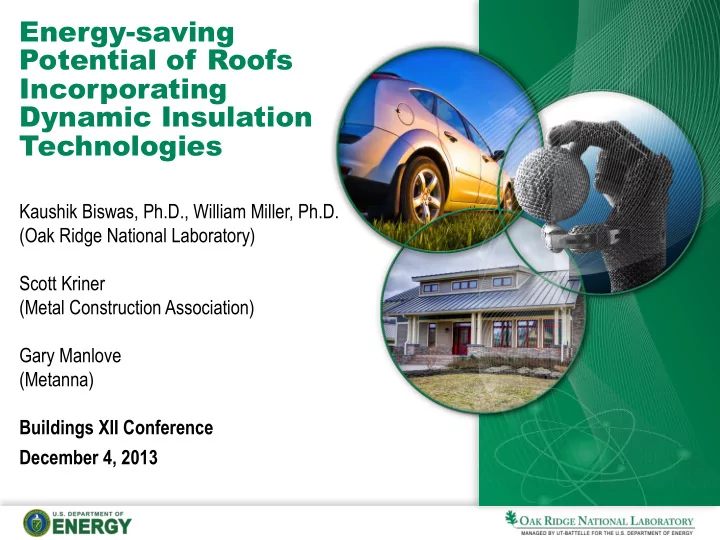

Energy-saving Potential of Roofs Incorporating Dynamic Insulation Technologies Kaushik Biswas, Ph.D., William Miller, Ph.D. (Oak Ridge National Laboratory) Scott Kriner (Metal Construction Association) Gary Manlove (Metanna) Buildings XII Conference December 4, 2013
Background • 2011 DOE Buildings Energy Data Book (using 1998 data) lists roofs as contributing – 12-14% of the heating and cooling loads in residential buildings – 12% of heating loads in commercial buildings • Reduction of roof and attic-generated space conditioning has been a topic for extensive research. • Energy-saving technologies considered: Ventilation, phase change materials, reflective and low-e surfaces, insulation, etc. 2 Presentation name
Introduction – Present Work • Performance of metal roofs incorporating dynamic insulation systems, including: – Above-sheathing-ventilation (ASV) – Phase change material (PCM) – Low-e surfaces – Rigid insulation • Phase 3 of an ongoing project; started in 2009. – Newer configurations based on findings from phases 1 and 2. • Goal: Evaluate different configurations of dynamic insulation systems to maximize energy savings. 3 Presentation name
Envelope Systems Research Apparatus (ESRA) • Test roofs were built on side-by-side attics in Oak Ridge, TN (mixed-humid climate). 4 Presentation name
Present Study – Three (3) Test Roofs • Each lane is an attic • Lane 6 (shingle roof) used as control/baseline • Note: The performance differences are based on whole roof systems; not intended to be a comparison of metal and shingle roofs. 5 Presentation name
Roof Construction Lane 2 Lane 3/4 PCM layer Rigid insulation PCM layer Rigid insulation • Lane 2: Rigid fiberglass insulation with low-e surface on top of PCM layer. • Lanes 3 and 4: PCM over rigid fiberglass insulation. • Metal subpurlins support the outer metal panel – In lanes 2 and 4, extra height of the subpurlins creates air gap for ASV 6 Presentation name
Typical ESRA Attic Instrumentation All attics are vented at the eave and ridge Roof Assembly Insulated Rear Wall and Gable • Onsite weather station to measure outdoor temperature and solar irradiance on the sloped roofs. • Heat flows into the attic and the conditions space below are positive ( heat gain ) and vice-versa ( negative for heat loss ) 7 Presentation name
Roof Surface Temperatures • No significant differences between the test and control roofs. • Performance differences primarily driven by the insulation systems below the roof surface. • Spurious data from Lane 3 roof thermocouple during the winter period as it became detached from roof surface. 8 Presentation name
PCM Behavior • Phase 1 study: The PCM layer below insulation remained frozen throughout winter ( Kosny et al., 2012, Solar Energy, v 86 ). • PCM in current lanes 3 and 4 (above insulation) underwent phase change throughout the year. • Melting and freezing temperatures obtained from differential scanning calorimetry tests. 9 Presentation name
Roof Heat Flux 80% or more peak heat flux reduction Heat flow reversal • 80-90% reduction in peak roof heat flux compared to the control roof. • Lane 2 (PCM below insulation) exhibits reversal of heat flow, presumably due to the melting of PCM. • Lower night time heat losses through test roofs(negative heat flux) 10 Presentation name
Attic Temperatures • Summer time peak attic temperatures in the test roofs were lower than control. • Conversely, nighttime temperatures were higher, especially during winter. 11 Presentation name
Ceiling Heat Flux • Ceiling heat flux directly impacts the heating and cooling loads and, hence, is a critical parameter. • Differences in attic temperatures are reflected in the ceiling heat flows: – Lower daytime heat gains (+ve) and lower night time heat losses (-ve) in the test attics. 12 Presentation name
Averaged Summer Data Attic temperature Ceiling heat flux • Data were ‘bin-averaged’, i.e. corresponding hourly data from each day averaged over the period Jun 1 to Sep 30, 2012. • Peak averaged attic temperatures ceiling heat fluxes: • Uncertainties in ceiling HFT measurements; not in accordance with attic temperature trends. 13 Presentation name
Averaged Winter Data Attic temperature Ceiling heat flux • Minimum averaged attic temperatures ceiling heat fluxes: 14 Presentation name
Summary & Future Work • Performance evaluation of three test roofs with different combinations of ASV, PCM, rigid insulation and low-e surface. • All three roofs showed potential to substantially reduced roof and attic-generated space conditioning loads. • Roof with PCM layer closer to the roof deck (under insulation) and the low-e surface performed better in summer. • Roof with PCM over insulation performed better in winter. • Future work: Whole-house energy modeling in different climate zones, using experimental data for validation. 15 Presentation name
Thank you! Questions? 16 Presentation name
Recommend
More recommend